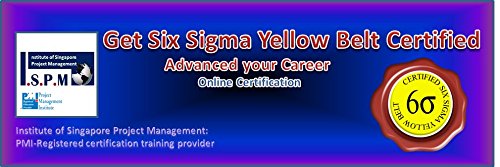
- Six Sigma Yellow Belt Training Outline Our Six Sigma Yellow Belt Training covers the following topics: 1) Introduction to Six Sigma 2) What is Six Sigma 3) Six Sigma History 4) Six Sigma Implementation Fundamentals 5) Six Sigma Teamwork; Roles and Responsibilities 6) Recognizing Opportunity with Six Sigma 7) Data-Driven Management 8) DMAIC and DMADV
- Six Sigma Yellow Belt Certification Our Six Sigma Yellow Belt Training has been pre-approved in Contact Hours by the Project Management Institute (PMI® USA) to fulfill certification eligibility and Continuing Certification Requirements (CCR). Professional development units (PDU) pre-approved for the Six Sigma Yellow Belt Training are: 10 PDU for PMI-PMP credential – Project Management Professional 10 PDU for PMI-PgMP credential – Program Management Professional 10 PDU for PMI-PfMP credential – Portfolio Management Professional 10 PDU for PMI-ACP credential – Agile Certified Practitioner 10 PDU for PMI-SP credential – Scheduling Professional 10 PDU for PMI-RMP credential – Risk Management Professional 10 PDU for PMI-PBA credential – Professional in Business Analysis * 10 PDU (Professional development units) = 1 CEU (Continuing Education Unit)
- Six Sigma Yellow Belt Objectives Six Sigma Yellow Belt Training provides an overall insight into the techniques of Six Sigma, its metrics, and basic improvement methodologies. Students will learn how to integrate Six Sigma methodologies for the improvement of production and transactional systems, in order to better meet customer expectations and bottom-line objectives of their organization. The course provides an introduction to process management and the basic tools of Six Sigma, giving students a stronger understanding of processes, enabling each individual to provide meaningful assistance in achieving an organization’s overall objectives.
- Six Sigma Yellow Belt Workshop Six Sigma education is a necessary part of many businesses today. It is a business management strategy that was originally developed by Motorola but has since been adopted by many other companies. There is some controversy about the subject but in its most simple form it functions to improve the quality of outputs in manufacturing and business processes. It is centered around identifying and eliminating errors and defects by using quality management methods. Each Six Sigma project includes statistical and financial targets. It is interesting to note where the term “six sigma” comes from. It actually originates from the idea that if you have six standard deviations between the specified limit and the mean, that every item will meet specifications. This is based on capability studies that measure standard deviation in sigma units. It is a math function that represents being efficient. Six Sigma projects usually follow two main methods. The DMAIC and the DMADV. They each have five phases and some similar processes. DMAIC is used primarily for improving existing business processes, while DMADV is used for creating new products and process designs.
- DMAIC has five different steps. The first is to define high-level goals and identify the current processes. Next is to measure the key parts of the current process and collect data that is relevant to the project. Then comes analyzing data to confirm cause-and-effect relationships. You have to find out what the relationships mean, and try and consider all of the factors. Next is to improve the process based on your previouis analyzation of the findings. This could be done with techniques like design of experiments. Last step to DMAIC is to control to make sure that there are no deviations from the target. This would mean setting up pilot runs and mechanisms to monitor all processes. DMADV has a similar first step in that it is to define goals for design that will meet strategy for customer demands. Next is to measure and identify characteristics that are critical to quality (CTQ’s), risks, and capabilities of the process. Following that is analayzing to find design alternatives, and to make a high-level design approach to select the best choice. Last is to verify the design, do some test runs, and put the production process to work and then give it back to the owners. The hierarchy to Six Sigma is set up much like martial arts with black belts, yellow belts and green belts. There are master black belts as well as champions and executive leadership. It is a vertical leadership model starting at the top with the Executive Leadership (CEO), and trickles down to the yellow belts. There is some controversy here as people have called it unoriginal and a flamboyant revamp of traditional facilitators. Other criticisms claim that although Six Sigma does effectively reduce errors and defects it also ends up stifling creativity because it does not allow for new products and technologies to be developed. No matter what your view is of Six Sigma education strategies, it is important to know how it works and how it applies to businesses.
What is Provided 1) Lifetime online access to all courses, including updates and revisions 2) Audio and Video lectures, in High-Definition HD quality 3) Printable course material 4) Workshop feature user-friendly tools for self-assessment and online practice exams for review 5) PDU (Professional Development Units) and CEU (Continuing Education Units) will be awarded and could be used for the maintenance and renewal of professional certifications. 6) Fulfilled educational requirements for Six Sigma Yellow Belt 7) Subtitles in English and more than 100 translation languages available for the course 8) Online and Email Support for our students for 12 months 9) Mobile access to Android, BlackBerry, Windows Mobile and iOS 10) Certificate of Attendance for Six Sigma Yellow Belt upon completion of the course 11) Certificate of Achievement for Six Sigma Yellow Belt upon passing the in-house exam.

